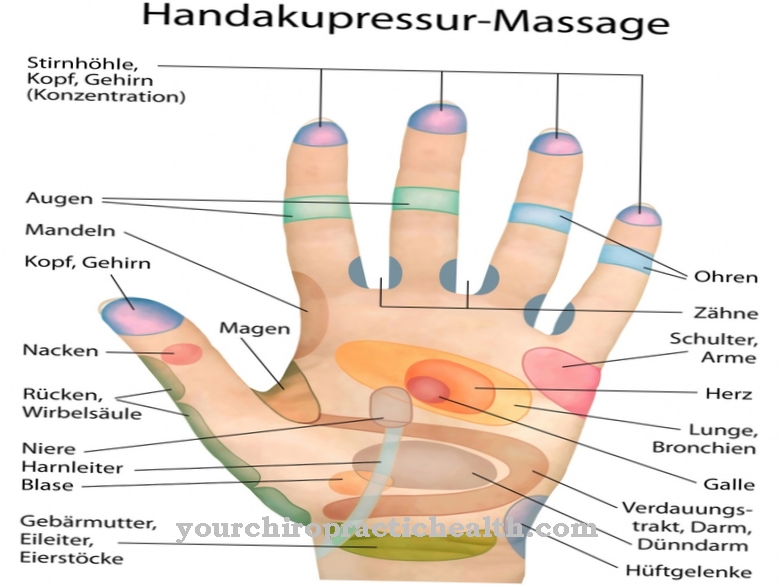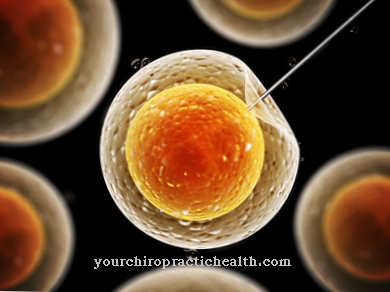The Polymerase chain reaction represents a method from molecular biology that duplicates sections of the genetic material (deoxyribonucleic acid, DNA). Millions of identical copies are made from tiny amounts of DNA. In this way, quantities are available that are sufficient for various investigations.
What is the polymerase chain reaction?

The term polymerase chain reaction (English: polymerase chain reaction, PCR) describes the in vitro (Latin: in glass) conversion with the help of an enzyme, the polymerase (DNA polymerase), which leads to the duplication of certain gene sequences. The product of the reaction is also the starting material for a new cycle of this reaction. The number of molecules doubles and at the same time serves as a template for a new cycle. One speaks of an exponential multiplication.
It takes place in the laboratory at a high speed of a few minutes, similar to a chain reaction. In this laboratory process, the duplication of genetic information (DNA) that occurs under natural conditions is imitated during replication. The American chemist K. B. Mullis is considered to be the discoverer of this process. He introduced this DNA synthesis method in 1983 and received the Nobel Prize in Chemistry ten years later.
Function, effect & goals
In living organisms, the DNA in the chromosomes is of a length that cannot be amplified using PCR. Instead, it is used to propagate a defined section. These can be genes, a certain part of a gene or areas that are not converted into proteins, i.e. are non-coding.
These segments usually do not exceed three thousand base pairs, compared to about two times three billion base pairs per chromosome set in humans. For the polymerase chain reaction, a single- or double-stranded DNA chain is required, the structure of which must be known at least in part. In addition to the enzyme, the polymerase, two primers are used. These are the building blocks of DNA that act as the start and end point. They are characterized by a sequence that exactly matches the area to be amplified.
In the laboratory, the polymerase chain reaction is carried out in a programmable heating block. The necessary components such as polymerase, primer, the building blocks to build up the new strand (deoxyribonucleoside triphosphate) and magnesium ions are combined in a buffer solution. The temperature-time program for the reaction starts with denaturation at a temperature above 94 ° C. The double-stranded DNA is cleaved and is single-stranded. In the next step, at around 70 ° C, the primer is bound to the gene sequence and forms the starting point for the enzyme reaction. The polymerase synthesizes the complementary strand from here.
A new cycle then begins, again consisting of the three steps of denaturation, primer binding and synthesis of the DNA strand. The polymerase chain reaction is used in forensic medicine, clinical diagnostics and clinical research. In criminology, DNA is obtained from the skin, saliva, hair, sperm or blood from crime scenes and, after amplification, compared with known samples and used to identify specific people.
With the help of this genetic fingerprint, paternity can also be clarified in a modified approach. When diagnosing diseases, the affected genes are verified with the help of the polymerase chain reaction. Some bacterial diseases can be classified by recognizing specific sequences. Virus diseases can be characterized when the virus DNA or RNA is converted and amplified. The blood donation service is able to detect hepatitis or HIV-mediated diseases at a very early stage.
It is used in tumor diagnostics to identify tumor cells. This enables the tumor to be classified, the course of the disease, the success of the therapy and the prognosis to be assessed. In research, the polymerase chain reaction is used to identify genes that are associated with various diseases.For the cloning of genes, which is not to be equated with the cloning of an organism, the gene is multiplied before it is transferred to other organisms in a vector (Latin: traveler, carrier). These can act as models to better study diseases, or to produce proteins that can be used as medicines.
You can find your medication here
➔ Medicines for paresthesia and circulatory disordersRisks & dangers
The polymerase chain reaction has huge potential in the detection of the smallest amounts of DNA. In order to be able to use the multitude of possibilities and to protect yourself from serious errors, certain requirements and various sources of error must be taken into account. Only sections of the genetic material whose sequence is known at least in part can be amplified.
Completely unknown sequences cannot be reproduced using this method. The products of an amplification can then be visualized. If the expected signal is not visible, although the sequence searched for was present, the result is false. Most often this is the result of poorly or poorly optimized reaction conditions. These must be determined depending on the target sequence. For this purpose, different temperature and time profiles, primer sequences and quantities as well as concentrations of other substances in the reaction mixture are tested. False positive results show up as signals that cannot be assigned to the desired product.
Contamination with DNA from the examiner or from a source other than the source to be analyzed creates major problems. DNA of bacterial origin also influences the result of a polymerase chain reaction. By wearing gloves and taking great care, such errors can be prevented and reliable statements can be made about the amplified products.


.jpg)










.jpg)

.jpg)
.jpg)











.jpg)